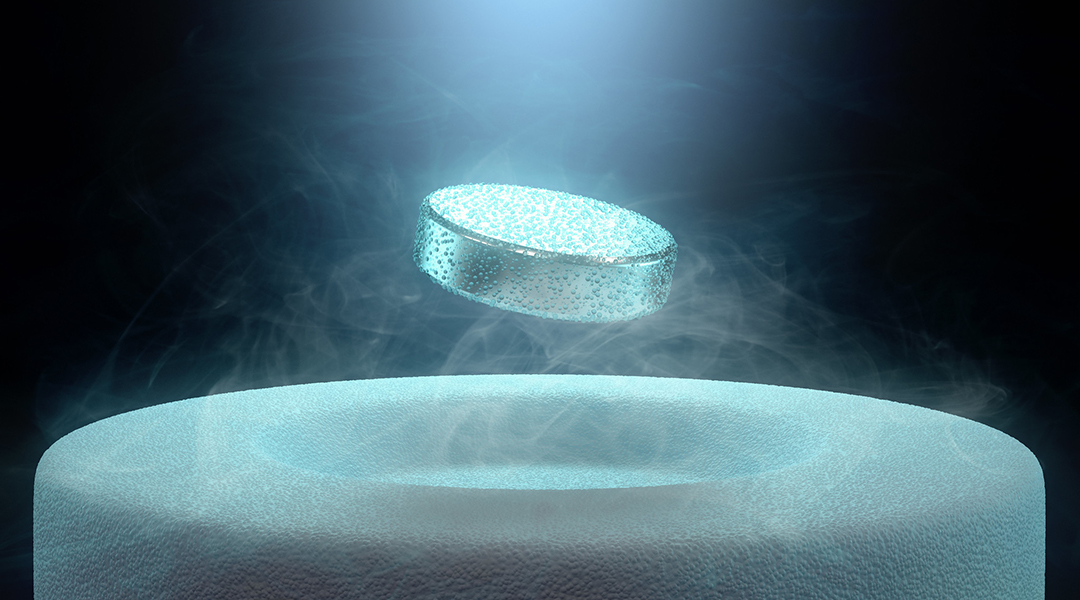Wires don’t usually like being the bearers of electric current. While we find them extremely useful to light our houses, charge our phones, and heat water for our tea, they routinely manifest their opposition to the flow of electricity by heating up. Because of this effect, called electrical resistance, the energy dissipated as heat is wasted, and the amount of electric current that a wire can carry before it melts is limited.
But a special kind of material is much happier to host electricity, so much so that under very low temperatures they do not exhibit any resistance. Superconductors, as they are known, don’t heat up at all and can thus carry much larger electric currents, which in turn makes them behave as extremely strong magnets. These superconducting magnets are part of MRI scanners, particle accelerators such as the ones at CERN, and the ultra-fast magnetic levitation trains being constructed in Japan, to name a few examples.
Since superconductivity was comprehensively studied in the 1950s, it has been traditionally classified into two main types. But a new paper in Advanced Science puts forward a third type of superconductivity that was previously only thought to apply to extremely thin layers of materials.
In the study, researchers develop the mathematical equations that describe this new type of superconductivity in thick, three-dimensional materials, and observe their behavior in the laboratory. The authors suggest that this new mechanism could open a door towards developing room-temperature superconductivity — a “holy grail” in the field.
Blocking magnets
Superconductors not only allow electrical current to pass without offering any resistance, they also block the action of magnets placed outside of them. The way they block these magnetic fields allows them to be classified into types bearing the unimaginative names type-I and type-II — and now, also type-III.
If you placed a type-I superconductor inside a magnetic field and looked at what happened inside it, you wouldn’t know the magnetic field was there as the superconductor screens it completely. However, if you make the magnetic field more and more intense, the superconductor eventually becomes unable to screen it. In doing so, it also stops behaving like a superconductor and reacquires its resistance to electrical current.
A type-II superconductor goes through an intermediate phase before its superconductivity breaks down. As the magnetic field becomes more intense, the material allows the field to pass but only through columns known as vortices. Inside these vortices there is no superconductivity but the rest of the material still behaves as a superconductor. If the magnetic field is raised even more, though, superconductivity disappears.
By carefully engineering certain materials one can go even further and build “islands” of superconductivity surrounded by a “normal zone”, as explained by Elsa Prada. Prada is a researcher at the CSIC Materials Science Institute of Madrid who was not involved in this study.
At first, these islands were studied in very thin layers of materials, sometimes stacked on top of each other, and the phenomenon came to be known as granular superconductivity.
Puzzled physicists
But Cristina Diamantini, a researcher at the University of Perugia, and her coauthors decided to explore whether thicker, three-dimensional materials could also present islands of superconductivity. “In three dimensions […] it was thought that [the traditional] mechanism could explain everything,” said Diamantini, and physicists were “puzzled” by the granular behavior.
In granular superconductors, the transition away from superconductivity is described by different mathematical equations than those of types I and II. But, up until now, those equations only applied to thin layers of materials. So Diamantini and her colleagues wondered, could those equations fit three-dimensional materials?
After lots of calculations they found out the answer was yes. Excitingly, this meant they had predicted that three-dimensional materials could also exhibit islands of superconductivity. They teamed up with an experimental group in Taiwan in order to try and observe it in real materials.
They tested two materials: niobium nitride and niobium titanium nitride, which are “very difficult to manipulate,” according to Mariela Menghini, researcher at IMDEA Nanociencia who was not involved in this study. But they succeeded and found that both matched the behavior predicted by the equations.
Further experiments will be needed to confirm these results, especially since the difficulty to manipulate the materials forced the researchers to make some non-standard choices, Menghini said, adding that more conventional measurements would make the results more convincing to the research community.
Unlocking new applications
If and when the confirmation occurs, this discovery could unlock a key insight in the study of superconductivity, as Valerii Vinokur, CTO US at Terra Quantum AG and senior author of the paper, explained. Superconductivity normally requires extremely low temperatures and that is an obstacle to its wide applicability, so achieving this effect at room temperature is the dream of many.
According to Vinokur, some materials which exhibit high-temperature superconductivity are granular just like the ones in the present study. “What we would like to do in our future research is try to see if [the theory in the present paper] can explain high-temperature granular superconductivity,” Diamantini added, as the team still needs to find out whether their newly developed equations describe high-temperature superconductors too.
“With our type-III [superconductivity] we think we really can indicate some mechanism which will allow us to raise the temperature and find new applications,” Vinokur said.
Reference: Cristina Diamantini, et al., Type-III Superconductivity, Advanced Science (2023). DOI: 10.1002/advs.202206523
Feature image credit: US Department of Energy on Flickr

















